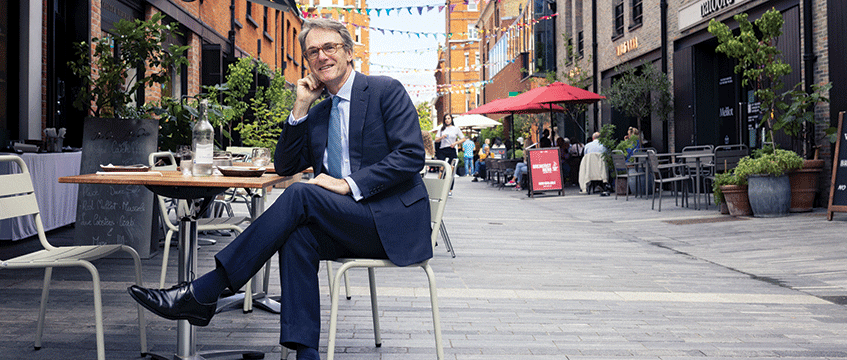Local identity is best served by returning to traditional architecture, forgoing the adolescent urge to modernism, argues Prince Charles.
It has always seemed to me that this is a nation of people who are proud of their distinctiveness, and do not want to be presented with an environment of soulless homogenisation. After all, this is so contrary to the individual character, wit and irony of the British people…
But after the industrial revolution, and with two world wars in close succession, we began to do things very differently, and standardisation took on a new scale and a new intensity. How coldly logical, when you think about it, that cigarettes were soon made to the exact diameter of rifle rounds, and soft drink cans to the diameter of mortar shells. Slowly, too, the production of housing became rather like a military operation.
But we know in retrospect that this concept took away one of the fundamentals of civilisation: the public realm. We lost the lane, the street and the square, which had provided the backdrop for the activities of public life.
But it seems to me, we might just be starting once again to recognise the importance of the “civic glue”, the binding social activities so vital to our social capital, and which underpin true sustainability.
Birth of a Slow Town Movement
Funnily enough, three weeks ago I was in Italy, speaking at a conference of 5,000 small farmers and food producers from all around the world, organised by something called the Slow Food Movement (the antithesis, of course, of the fast food movement whose global tentacles will, at the rate we are going, eventually strangle the health and welfare of both people and their communities, as well as the Earth’s capacity to survive). The, dare I say it, “fast building movement” will do the same, unless we recognise the need for slower buildings and, with them, the long delayed restoration of the vital balance between efficiency and romance. As Ruskin once said, “industry without art is brutality”.
In Italy, a number of people have called for a Slow Town Movement that draws on the kind of principles established by the Slow Food Movement — local sourcing of materials, sustainability, environmental awareness and encouraging diversity above mass production.
Consider the production of housing over the centuries: each community developed its own collective character, even though building components were almost universally standard. It seems to me that the problem with most standardised housing is that it lacks this individual character; instead, it relies on abstract shapes and colours to make it feel different.
One of the important issues my foundation is engaged with at present is that of persuading designers and planners to listen to what scientists have to say about nature’s way of handling large numbers. Nature offers clues as to how quantity and quality can go hand in hand; how a complex order can respect diversity; how we can again achieve the fine grain of scale that makes buildings and streetscapes such a delight; and, what is more, how one can be truly sustainable by being adaptive. It is time, I think, for a new approach.
And perhaps it is worth asking, have you ever noticed that my saying anything about the built environment seems guaranteed to elicit howls of outrage from various establishments? But perhaps I could remind you all that architecture is the most public of art forms, and as such, it dramatically affects our lives and our psychological well-being like no other.
Last year, the deputy prime minister mentioned the “wow factor” in relation to delivering the new building programme. I certainly agree that artistic innovation is part of the adventure of architecture. But if we want a truly sustainable built environment, we must not let artistic abstractions override the subtle patterns of human life – the kind of fashionable obsessions that, if they have no organic roots, will invariably end up as expensive and incredibly wasteful mistakes some 30 years later. Hardly a recipe for sustainability.
So surely the time has come to escape from an almost adolescent obsession with being modern – the product, perhaps, of a 20th-century teenage crisis? – and, instead, to be more concerned about being human! And it is surely sensitivity or courtesy (courtesy to the public realm and to the natural environment) that are so badly needed if we are to avoid the uglification of what is left of our small island.
But why the need to be egotistical – as if, again in an adolescent way, we feel it necessary to reflect our presence for posterity by leaving behind the equivalent of graffiti on the beauty of nature? Surely it is time to be grown up enough to realise that what sustainability really means is paying the necessary respect and good manners due to nature, to that “sense of place”, which have been so arrogantly denied to her, and with such recognisably disastrous consequences to our planet?
Modernism is pastiche
Isn’t it curious, too, that copying from history – “pastiche” as they call it – is simply assumed to be wrong. And yet what is fashionable today is another kind of pastiche – of almost century-old Modernist architecture. Why does that reflect our time any better?
As we are tempted by economies of scale toward off-site production systems, let us be very careful to get the balance right. Certainly we can gain some benefits from the economies of scale and off-site production, as builders have been doing for centuries. But there must be a place for local craftspeople to make the critical link to local identity in the character of buildings and, in particular, the way the facade addresses the street and the public realm. To be successful, this requires a fine grain of adaptation.
If off-site production is not to prove a false economy (and it has been suggested recently that the concept has more to do with ideology than practicality, as it would cost twice as much to build the components in factories and transport them to the site as to put up scaffolding and build houses in the conventional way, but I dare say there have been lots of arguments about that), then it must be integrated with other, local economies: let us not be penny-wise and pound-foolish, ignoring local employment, historic conservation and tourism. Let us remember the enormous economy in natural and cultural capital, and in enduring pride of place.
Communities need the right infrastructure
Let us also be mindful of those areas of the country which are expected to absorb additional housing; they may well run a substantial risk that it will not be supported by the necessary infrastructure, and thus unsustainable communities will result. The fact is that the time to build a housing estate is much quicker than the time to create the attendant transport, education and inward investment that are necessary for the creation of an integrated and sustainable community.
Private companies are always prepared to build profitable housing estates, but when it comes to infrastructure, it is often an entirely different story and history is littered with examples of good intentions, changed economic climates and rapidly moving goalposts.
What needs to be said I think is that now is the time to understand that there is such a thing as a living tradition, and bring our traditional craftspeople in from the cold: we should encourage them to apply their skills to new building. These living skills should be drawn to the attention of all architecture students as an important resource. After all, how can you possibly construct beautiful, pleasing sentences that stir the heart and impart lasting meaning to our lives without the building blocks provided by a syntax that in itself is organic, rather than genetically engineered in the “fast building” laboratory?
I feel a new consensus emerging, a new kind of modernity, if you will. It implies that we can find effective ways of dealing with the big problems of our day, which do not oblige us to bury beneath our abstractions the very things that make life worth living – the types of places we all know strike a chord in our bewildered hearts, however “modern” we are.
Edited extracts from a speech by HRH the Prince of Wales on “Local Identity in a Fast-Track Age” at the Prince’s Foundation for the Built Environment, Shoreditch, London, 18 November 2004










